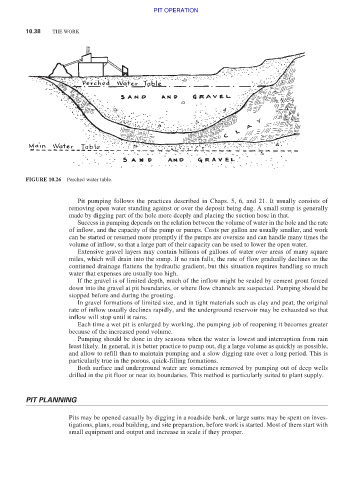Page 532 - Moving the Earth_ The Workbook of Excavation
P. 532
PIT OPERATION
10.38 THE WORK
FIGURE 10.26 Perched water table.
Pit pumping follows the practices described in Chaps. 5, 6, and 21. It usually consists of
removing open water standing against or over the deposit being dug. A small sump is generally
made by digging part of the hole more deeply and placing the suction hose in that.
Success in pumping depends on the relation between the volume of water in the hole and the rate
of inflow, and the capacity of the pump or pumps. Costs per gallon are usually smaller, and work
can be started or resumed more promptly if the pumps are oversize and can handle many times the
volume of inflow, so that a large part of their capacity can be used to lower the open water.
Extensive gravel layers may contain billions of gallons of water over areas of many square
miles, which will drain into the sump. If no rain falls, the rate of flow gradually declines as the
continued drainage flattens the hydraulic gradient, but this situation requires handling so much
water that expenses are usually too high.
If the gravel is of limited depth, much of the inflow might be sealed by cement grout forced
down into the gravel at pit boundaries, or where flow channels are suspected. Pumping should be
stopped before and during the grouting.
In gravel formations of limited size, and in tight materials such as clay and peat, the original
rate of inflow usually declines rapidly, and the underground reservoir may be exhausted so that
inflow will stop until it rains.
Each time a wet pit is enlarged by working, the pumping job of reopening it becomes greater
because of the increased pond volume.
Pumping should be done in dry seasons when the water is lowest and interruption from rain
least likely. In general, it is better practice to pump out, dig a large volume as quickly as possible,
and allow to refill than to maintain pumping and a slow digging rate over a long period. This is
particularly true in the porous, quick-filling formations.
Both surface and underground water are sometimes removed by pumping out of deep wells
drilled in the pit floor or near its boundaries. This method is particularly suited to plant supply.
PIT PLANNING
Pits may be opened casually by digging in a roadside bank, or large sums may be spent on inves-
tigations, plans, road building, and site preparation, before work is started. Most of them start with
small equipment and output and increase in scale if they prosper.

